
The Arctiinae are a large and diverse subfamily of moths with around 11,000 species found all over the world, including 6,000 neotropical species. This subfamily includes the groups commonly known as tiger moths, which usually have bright colours, footmen, which are usually much drabber, lichen moths, and wasp moths. Many species have "hairy" caterpillars that are popularly known as woolly bears or woolly worms. The scientific name Arctiinae refers to this hairiness. Some species within the Arctiinae have the word "tussock"' in their common names because they have been misidentified as members of the Lymantriinae subfamily based on the characteristics of the larvae.

The cinnabar moth is a brightly coloured arctiid moth found as a native species in Europe and western and central Asia then east across the Palearctic to Siberia to China. It has been introduced into New Zealand, Australia and North America to control ragwort, on which its larvae feed. The moth is named after the red mineral cinnabar because of the red patches on its predominantly black wings. The species was first described by Carl Linnaeus in his 1758 10th edition of Systema Naturae. Cinnabar moths are about 20 mm (0.79 in) long and have a wingspan of 32–42 mm (1.3–1.7 in).

The common footman is a moth of the family Erebidae. The species was first described by Johann Leopold Theodor Friedrich Zincken in 1817. It is distributed throughout Europe and east through the Palearctic to Lake Baikal.

Citheronia azteca is a moth of the family Saturniidae that lives in Guatemala, Belize and Mexico.

Abraxas sylvata, the clouded magpie, is a Palearctic moth of the family Geometridae that was named by Giovanni Antonio Scopoli in 1763.

Zizina labradus, the common grass blue, grass blue, or clover blue, is a small Australian butterfly of the family Lycaenidae.

Cydia nigricana, the pea moth, is a moth of the family Tortricidae. It is found in Europe.
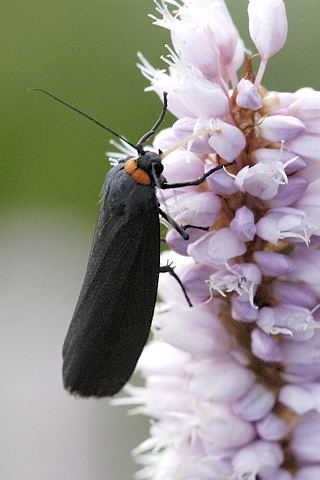
Atolmis rubricollis, the red-necked footman, is a small moth of the family Erebidae. It is found in the summer in forested regions of Europe and Northern Asia. This moth was first described by Carl Linnaeus in his 1758 10th edition of Systema Naturae.

Miltochrista miniata, the rosy footman, is a moth of the family Erebidae. The species was first described by Johann Reinhold Forster in 1771. It is found in the temperate parts of the Palearctic realm – Europe, Asia Minor, Caucasus, northern Kazakhstan, southern Siberia, Amur, Primorye, Sakhalin, southern Kuriles, Heilongjiang, Liaoning, Hebei, Inner Mongolia, Shanxi, Sichuan, Korea and Japan, but may be replaced by Miltochrista rosaria in the eastern Palearctic.
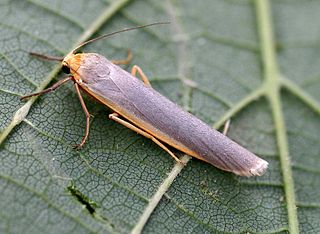
Manulea complana, the scarce footman, is a moth of the family Erebidae. The species was first described by Carl Linnaeus in his 1758 10th edition of Systema Naturae. It is found throughout the Palearctic region.

Manulea is a genus of moths in the family Erebidae erected by Hans Daniel Johan Wallengren in 1863. The type species is Lithosia gilveola Ochsenheimer, 1810.

Setina aurita is a moth of the family Erebidae. It was first described by Eugenius Johann Christoph Esper in 1787.
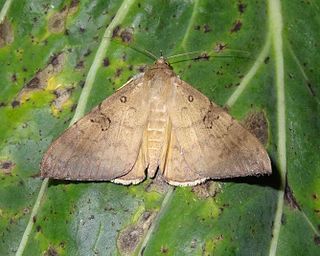
Oxyodes scrobiculata, the longan semi-looper or longan leaf-eating looper, is a moth of the family Erebidae. The common name "looper" is used despite looper moths generally being in the family Geometridae. The species was first described by Johan Christian Fabricius in 1775. It is found in the Indo-Australian tropics of India, Sri Lanka, Myanmar, China, east to Guam, Queensland, New Caledonia, Fiji, Samoa and Tonga.
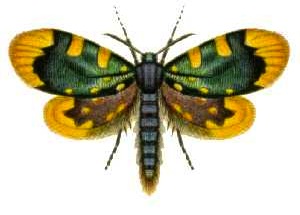
The Australian bagmoth or lichen bag moth is a moth of the Psychidae family. It is found in New Zealand and the southern half of Australia.

Anestia ombrophanes, the clouded footman, is a moth of the subfamily Arctiinae. The species was first described by Edward Meyrick in 1886. It is known from the Australian Capital Territory, New South Wales, Queensland, Western Australia, Victoria and South Australia.
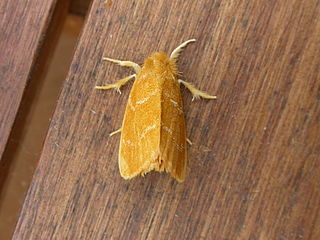
Euproctis lutea, the fresh-water mangrove itchy caterpillar, is a species of moth of the family Erebidae. It is found in northern Australia and New Guinea.

Lyclene structa is a species of moth of the subfamily Arctiinae first described by Francis Walker in 1854. It is found in the southern half of Australia.

Citheronia laocoon is a species of moth in the family Saturniidae. It is found from the Guianas south to northern Argentina.

Manulea bicolor, the bicolored moth or yellow-edged footman, is a moth of the family Erebidae. It is found in boreal North America, from Labrador and Massachusetts to Yukon and British Columbia. In the Rocky Mountains, it ranges south to southern Colorado. The habitat consists of boreal forests, parklands and riparian cottonwoods in the prairies.
Cyana meyricki is a moth of the family Erebidae first described by Walter Rothschild and Karl Jordan in 1901. It is found in Australia, where it has been recorded from Queensland and New South Wales.





















